Online Magazine
Recent Posts
- Safeguard your Cellphone Photos
- Black & White to Color – Instantly
- Wearing Many Hats
- Video Roundup
- Rescuing Your Blurry Pictures
- Showing Their Age
- What is Your Angle?
- Panorama Photos
- Humorous Photos
- Close Ups
- Fisheye Pictures
- Photo Antiquities
- Printing Big
- Appreciating Scale
- Celebrity Sightings
Tags
More Places to Go
- Free "How-To" Books “How To” books for popular cameras 0
- Vist Us on Facebook keep in touch with us on Facebook 2
Archives
- July 2023 (1)
- March 2023 (2)
- February 2023 (1)
- December 2022 (1)
- October 2022 (1)
- September 2022 (8)
- August 2022 (9)
- July 2022 (1)
- June 2022 (1)
- June 2021 (1)
- May 2021 (1)
- March 2021 (5)
- February 2021 (4)
- January 2021 (2)
- April 2019 (1)
- March 2019 (1)
- February 2019 (1)
- October 2018 (2)
- April 2018 (1)
- March 2018 (4)
- February 2018 (1)
- November 2017 (1)
- August 2017 (1)
- June 2017 (1)
- April 2017 (1)
- March 2017 (5)
- February 2017 (2)
- January 2017 (1)
- October 2016 (1)
- September 2016 (1)
- August 2016 (1)
- July 2016 (1)
- May 2016 (1)
- April 2016 (1)
- March 2016 (2)
- February 2016 (1)
- January 2016 (2)
- December 2015 (1)
- November 2015 (1)
- October 2015 (3)
- April 2015 (1)
- March 2015 (5)
- February 2015 (1)
- January 2015 (4)
- December 2014 (2)
- November 2014 (5)
- October 2014 (2)
- September 2014 (1)
- August 2014 (2)
- July 2014 (1)
- May 2014 (1)
- April 2014 (5)
- March 2014 (5)
- December 2013 (2)
- November 2013 (18)
- October 2013 (1)
- September 2013 (1)
- August 2013 (1)
- July 2013 (1)
- June 2013 (3)
- May 2013 (1)
- April 2013 (2)
- March 2013 (1)
- February 2013 (1)
- January 2013 (1)
- December 2012 (1)
- November 2012 (2)
- October 2012 (2)
- September 2012 (5)
- August 2012 (2)
- July 2012 (1)
- June 2012 (1)
- May 2012 (1)
- April 2012 (4)
- March 2012 (1)
- February 2012 (1)
- January 2012 (3)
- December 2011 (1)
- November 2011 (3)
- October 2011 (1)
- September 2011 (2)
- August 2011 (2)
- June 2011 (3)
- May 2011 (4)
- April 2011 (8)
- March 2011 (8)
- February 2011 (10)
- January 2011 (6)
- December 2010 (11)
- November 2010 (14)
- October 2010 (6)
- September 2010 (12)
- August 2010 (2)
- July 2010 (4)
- June 2010 (3)
- May 2010 (1)
- April 2010 (1)
- March 2010 (2)
- February 2010 (1)
- January 2010 (1)
- December 2009 (1)
- November 2009 (2)
- October 2009 (2)
- September 2009 (1)
- August 2009 (3)
- July 2009 (2)
- June 2009 (1)
- May 2009 (2)
- April 2009 (1)
- March 2009 (2)
- February 2009 (1)
- January 2009 (3)
Seen at WPPI – Quality Printing Papers
12th March 2017
Some Day My Prints Will Come
For decades I was schooled in conventional (film) photography. So it’s natural that I am a lover of photographic prints. And although I enjoy the convenience and portability of electronic display devices, I simply prefer to view my work on hardcopy prints.
Last last year, I ordered a large format printer – the Epson P800. Normally it makes prints up to size 17″ x 22″. Add a roll paper feeder and it can produce enormous panoramas up to 129″ wide. Since the printer was in high demand at the time, my waiting time was about a month for delivery.
When I finally received the printer, I was preoccupied with a lot of other work. To ensure that the printer was working properly I used to make only two or three prints and then set it aside.
Jump ahead two months and I’m attending the WPPI Conference & Expo. I think to myself that I should learn about printing papers to get the best results from the investment in my Epson P800. And so at WPPI I stop at several makers of fine art papers to get educated.
|
|
|
| Hahnemuhle is a German based company that offers a wide variety of papers. I look at their large catalog and am stumped by some of the terminology. So I start asking questions.
What is baryta paper? I’m told that it is paper coated with barium sulphate, a substance used on traditional photographic paper. When baryta paper is used for inkjet printing, it supposedly reproduces the effect of silver halide processing. Many of the paper descriptions include a gsm value. I find that gsm is an acronym for grams per square meter. Thus a square meter of Canvas Metallic 350 gsm paper is heavier than FineArt Baryta Satin 3500 gsm paper. I am also curious about paper with the rag description. I learn that this paper is made from cotton linters or rags and is superior to wood-based paper. |
 |
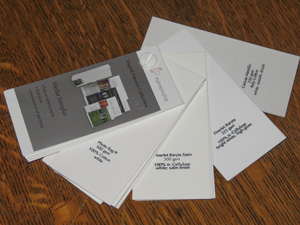 The helpful representative left me with this sampler – a collection of their fine art photography papers and other helpful literature. For more information please visit Hahnemuhle. |
 |
|
|
|
| Namhoon Kim is the Marketing Manager for Durico Media. The company is based in southern California. As you can see from the below photograph, they have a rather large selection of papers.
I helped myself to about a dozen of their print samples all on different paper stock. I find that the samples are the only way to determine if a paper is suitable for one of my prints. Reading a catalog description does not give me the know-how to select a paper – I require hands-on to feel the surface and a sample photograph to give me the visual feedback. For more information, please visit Durico Imaging. |
 |
 |
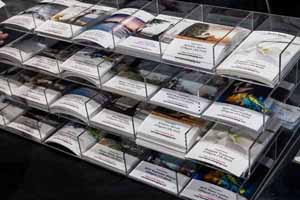 |
|
|
|
| Epson is probably best known as a manufacturer of printers. They also are a large producer of high quality printing papers.
My visit to Epson is to find out more about their printing papers and luckily I am handed a “Print Sample Guide” to take with me. It has their complete line of papers with printed samples: photographic, matte, cotton fine art and canvas. Before I depart the representative shows me their new software Epson Print Layout. This app is for users of Epson professional printers and provides a convenient and elegant way to organize, set up and print your images. If you’re a user of a high end Epson printer, you can download a copy of the Epson software from here. For more information about their papers, please visit Epson. |
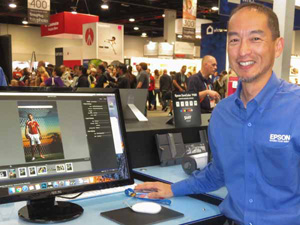 |
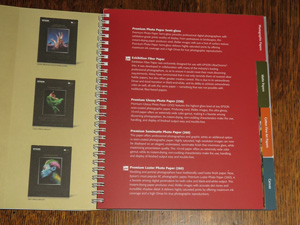 |
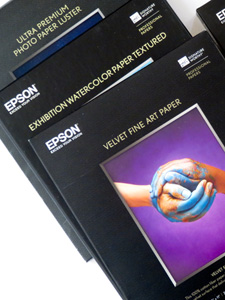 |
|
|
|
| Paperwise, I’m 3 for 3. I walked away with samples from three different manufacturers. So with samples in hand, I am prepared to make my paper choices. Now I’m ready to fire up that printer that has been sitting idle waiting for me. | |
Written by: Arnie lee
Seen at WPPI – DJI Mavic Pro
11th March 2017
Hover and Shoot
|
|
|
| You don’t ordinarily think of looking at drones at the Wedding and Portrait Photography International Conference & Expo. However, DJI had a booth there showing off the new Mavic Pro. | |
|
|
|
| At the DJI booth, representative Laura Schutz showed me the company’s newest drone. She emphasized that drones are now simpler to fly. And drones are now much more affordable.
Users have invented innovative ways to use drones for airborne photography. DJI, a pioneer in the industry, recently released the Mavic Pro which builds on the simpler and affordable features. |
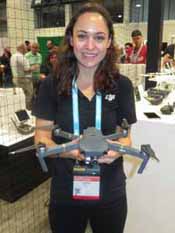 |
|
|
|
| The Mavic Pro is compact. When not in use, the rotor arms fold tightly against the unit’s body making it easy to store and transport.
Owing to its efficient motors, flying time is up to 27 minutes at 40 mph. The unit’s remote controller has a range of more than 4 miles. It can send livestream directly to popular smartphones. Mavic Pro has five built-in sensors that can detect and avoid obstacles during flight. There is also a set of backup sensors that can take over in case one is malfunctioning. |
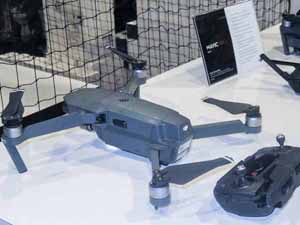 |
|
|
|
| Specifically for photography is a camera that shoots 4K at 30fps mounted on 3-axis gimbal for smooth, jumpfree video. Stills are captured at 12MP.
Its GPS capabilities enable accurate positioning whatever your location. In “ActiveTrack” mode, the drone follows or flies alongside the subject. In “Gesture Mode”, the Mavic follows you until you give it the go-ahead to snap your “selfie”. The “Terrain Follow” mode flies the drone at a fixed altitude above the ground. |
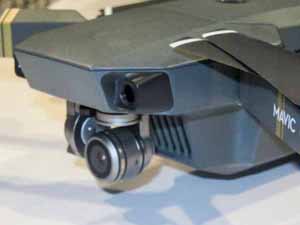 |
|
|
|
| This Mavic Pro is taking video footage of me.
The Mavic Pro has many features which set it apart from other drones. The DJI website has many videos that demonstrate these features. |
 |
|
|
|
| The suggested price of the Mavic Pro is $1000.
For more information about the Mavic Pro, please visit DJI. |
|
|
|
|
Written by: Arnie Lee
Seen at WPPI – Canon M5
10th March 2017
Canon’s Latest Mirrorless
|
|
|
| This past February at the Wedding and Portrait Photography International Conference & Expo, I stopped at the Canon booth to take a look at the company’s new M5 mirrorless interchangeable lens camera. | |
|
|
|
| Canon is best known for their full featured DSLR cameras. Although I own several high end DSLRs from both Canon and Nikon, I’ve been a devoted user of mirrorless cameras for at least five years owing to the compact size and electronic viewfinder that I highly value.
Sony has been a leader in the mirrorless realm with Fujifilm, Panasonic and Olympus close behind. Canon has been playing catch up with its M series for a couple of years. I now consider the M5 a strong contender. The new M5 now uses a 24MP sensor with Dual Pixel AF for faster and more precise autofocus. This is Canon’s first M series with built-in viewfinder. The M5 combines in-camera digital and optical lens stabilization. The tilting LCD has doubles as a touchscreen. And the camera has a built-in flash. |
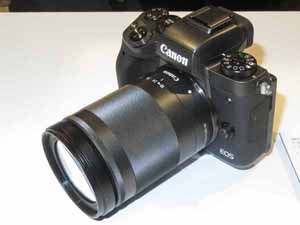 This is the Canon M5 with the 18-150mm EF-M lens. |
|
|
|
 The tilting LCD also functions as a touchscreen. Touch the screen to activate focus manually. |
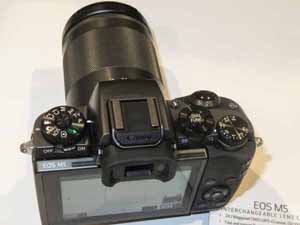 As you can see the M5 has a convenient, dedicated exposure compensation dial. |
|
|
|
| The M5 also captures full HD 60p movies in MP4 format. The touchscreen can be used during video operations to affect focus.
The camera includes Wi-fi and NFC capabilities as well as bluetooth to send images to a smartphone. The suggested price of Canon M5 with 15-45mm EF-M lens is $1099. The suggested price of the Canon M5 with the 18-150mm EF-M lens is $1479. For more information about the M5, please visit Canon. |
|
|
|
|
Written by: Arnie Lee
« Older Posts — Newer Posts »